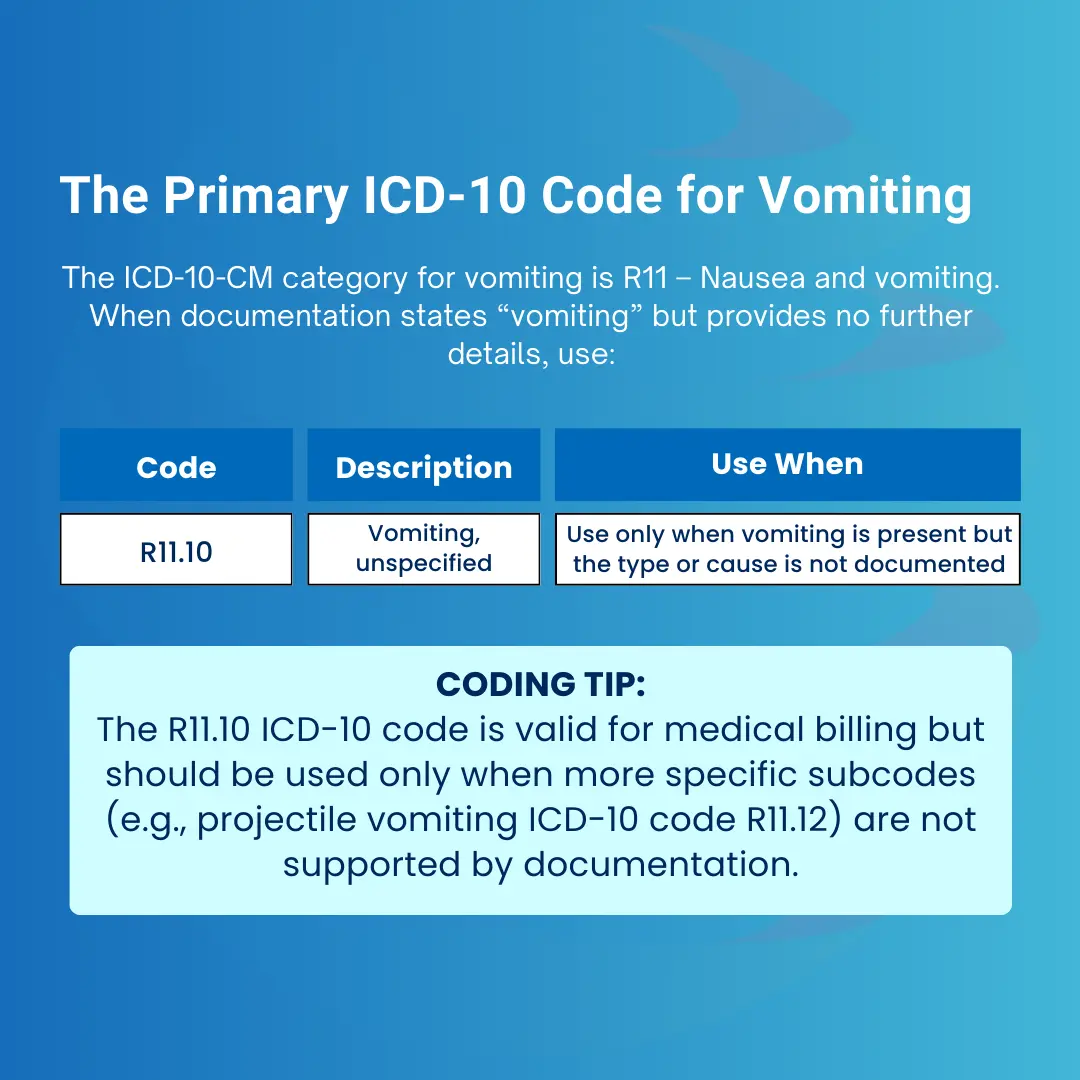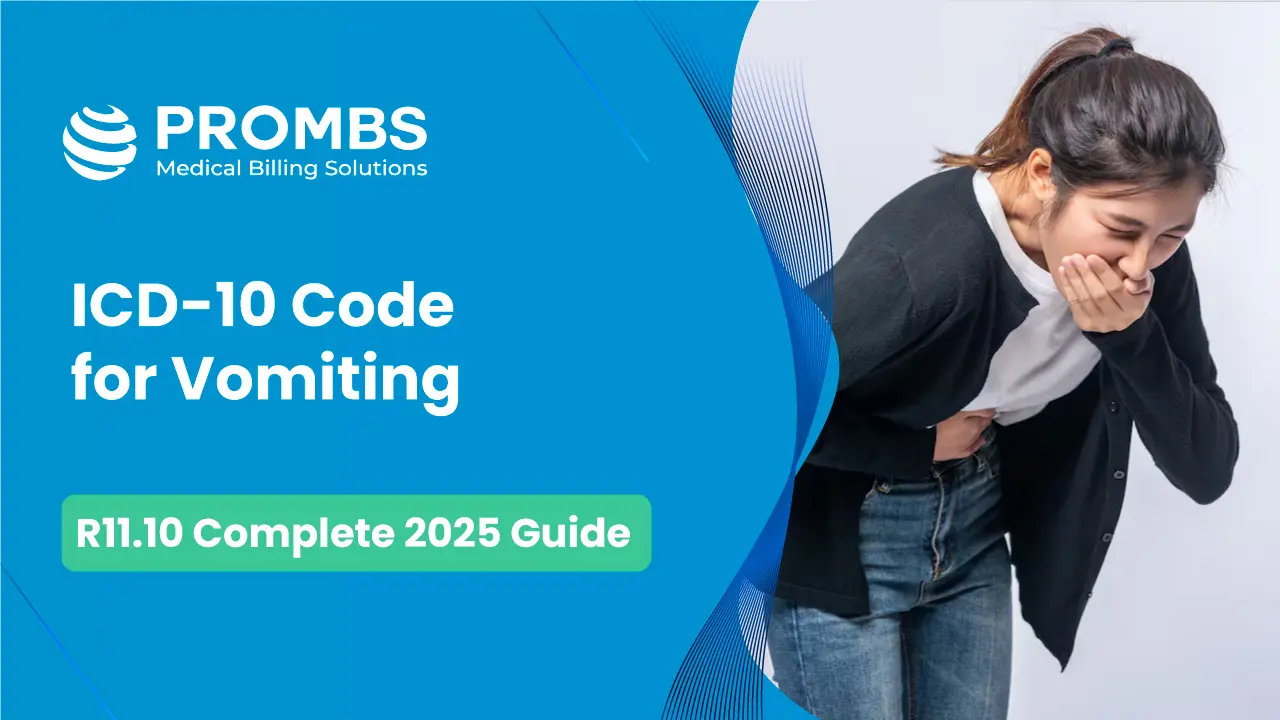In ICD-10-CM coding, vomiting is a common symptom code found under Chapter 18 Symptoms, signs, and abnormal clinical and laboratory findings, not elsewhere classified (R00–R99).
Accurately coding vomiting is essential for claim acceptance, payer compliance, and clinical data accuracy.
For coders, the challenge lies in:
- Determining when to assign the ICD-10 code for vomiting as a principal diagnosis vs. a secondary symptom.
- Choosing between vomiting unspecified (R11.10) and more specific ICD-10 vomiting codes when documentation allows.
- Preventing claim denials caused by overuse of unspecified symptom codes.
This guide covers the R11.x vomiting ICD-10 code range, related codes like R11.2 nausea with vomiting, and pregnancy-related vomiting codes from the O21 series, along with documentation tips, denial prevention, and best practices.
Understanding the Process of Vomiting
Vomiting (emesis) is the forceful expulsion of gastric contents through the mouth, triggered by the vomiting center in the medulla oblongata.
Physiological Process:
- Trigger stimulus (GI irritation, toxins, pregnancy, CNS signals)
- Activation of the chemoreceptor trigger zone (CTZ)
- Reverse peristalsis and abdominal contraction
- Expulsion of gastric contents
Clinical Relevance in Coding:
If vomiting is due to a known cause, such as gastroenteritis, chemotherapy, or pregnancy, the underlying condition should be coded first to reflect the primary reason for the encounter. However, if no cause is documented, the most specific ICD-10 vomiting code available from the R11 category should be assigned based on the details provided in the clinical documentation.

Related ICD-10 Codes for Vomiting
| ICD-10 Code | Description | Usage Criteria |
|---|---|---|
| R11.0 | Nausea | Only nausea is documented |
| R11.1 | Vomiting | Parent category (non-billable) – see subcodes below |
| R11.11 | Vomiting without nausea | Use when vomiting occurs without accompanying nausea |
| R11.12 | Projectile vomiting | Sudden, forceful expulsion (common in pyloric stenosis) |
| R11.13 | Vomiting of fecal matter | Often linked to intestinal obstruction |
| R11.14 | Bilious vomiting | Green/yellow vomit caused by bile reflux |
| R11.15 | Cyclical vomiting syndrome, not intractable | Recurrent vomiting episodes without clear cause |
| R11.2 | Nausea with vomiting, unspecified | Use when both symptoms are documented without more detail |
| O21.x | Excessive vomiting in pregnancy | Use for pregnancy-related cases (hyperemesis gravidarum) |
Excludes 1 Notes:
- Cyclical vomiting with migraine → G43.A-
- Excessive vomiting in pregnancy → O21-
- Psychogenic vomiting → F50.89
- Postoperative vomiting → Symptom code plus relevant postprocedural complication code
Documentation Requirements
To code vomiting accurately, provider documentation must include:
- Clearly state when the vomiting began, how often it occurs, how long it has lasted, and its severity
- Indicate whether nausea is present or absent
- Specify the type of vomiting, such as projectile, bilious, or feculent
- Record any associated symptoms like abdominal pain, diarrhea, fever, or headache
- Mention possible triggers, including infections, pregnancy, or medication reactions
- Include relevant diagnostic evidence, such as lab results or imaging findings
- Document special considerations like pregnancy status or the patient’s age in pediatric cases
- State the underlying cause explicitly if known, for example, “vomiting due to gastroenteritis”
Why Vomiting Codes Get Denied
Payer denials for vomiting-related claims often stem from avoidable coding and documentation errors. One of the most frequent issues is the overuse of R11.10 (vomiting, unspecified) when the medical record actually supports a more specific ICD-10 code, such as projectile vomiting (R11.12) or bilious vomiting (R11.14). This downcoding not only reduces clinical accuracy but also signals poor documentation practices to payers. Another common problem is incorrect sequencing, where vomiting is assigned as the principal diagnosis even though it is clearly secondary to a more specific condition, such as gastroenteritis or chemotherapy-related side effects. In these cases, the underlying condition should be listed first to comply with ICD-10-CM coding guidelines.
Pregnancy coding errors also contribute to denials, particularly when O21.x hyperemesis gravidarum codes are applied to non-pregnant patients due to misinterpretation of documentation. Documentation gaps such as missing onset, frequency, type, or related symptoms make it impossible to select the correct code and can lead to payer queries or outright denials. Finally, the failure to link vomiting to a known cause when documented in the record (e.g., “vomiting due to small bowel obstruction”) not only violates sequencing rules but can also misrepresent the patient’s clinical picture. Addressing these issues through precise coding, clear provider documentation, and pre-submission claim reviews is essential for clean claim acceptance.
Best Practices for ICD-10 Coding of Vomiting
- Always code the most specific R11.x code supported by documentation.
- If cause is known, code the cause first, followed by vomiting if clinically relevant.
- Use O21.x codes for pregnancy-related vomiting only.
- Apply excludes notes strictly to prevent payer rejections.
- Conduct pre-submission edits to catch mismatched diagnosis and symptom codes.
- Educate providers on documenting vomiting type and presence of nausea.
Pro-MBS Expertise in ICD-10 Coding & Denial Prevention
Our coding team applies a rigorous, compliance-driven approach to symptom coding that directly reduces payer denials and optimizes reimbursement outcomes. For vomiting-related claims, we conduct in-depth chart reviews to ensure clinical documentation supports the selected ICD-10 code, validate each code against the latest ICD-10-CM guidelines and payer-specific rules, and perform targeted denial analysis to identify and eliminate recurring errors. This process is supported by structured provider training focused on improving documentation completeness and specificity for symptom-based encounters.
By integrating these measures into our workflow, we consistently achieve higher first-pass acceptance rates, minimize denials related to vomiting and other symptom codes, and accelerate overall payment turnaround. Our methodology ensures that every claim meets both regulatory requirements and payer expectations, safeguarding revenue integrity while maintaining strict coding compliance.
